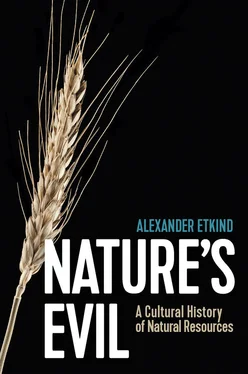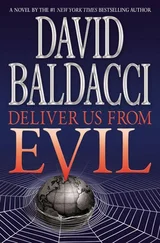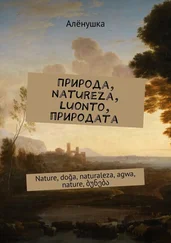The first farmers were marsh dwellers, and their greatest skill was not ploughing or irrigation but the ability to drain water. The anthropologist James C. Scott describes how nomads came to the flood plains of Mesopotamia about 6,000 years ago. The sea level was higher than it is now. The changing courses of rivers great and small criss-crossed broad tracts of marshland. Regular floods washed away weeds and brought in silt, in which cereals and beans could be sown. Thanks to annual flooding, the soil was never exhausted. It was at this time that the selective breeding of plants began, as well as the domestication of cattle and the building of houses and boats from reeds. Probably it was at this period that people learnt to dig up, dry and burn peat – a crucial skill for surviving in wetlands (see chapter 11). Although these people sowed seed on the available plots of land and harvested crops from them, they had no inclination towards private ownership. It seems likely they had no enemies. The wetlands protected these first peasant farmers from the attention of the desert nomads. 1
As Scott describes it, Mesopotamia was not unlike Holland on the eve of the Golden Age. On various continents, civilisation took its first steps in wetlands; this is how the first settled populations arose along the Jordan, Nile, Niger, Indus and Amazon rivers, and then in the early rice states of Africa and China. The central role of wetlands in the history of civilisation has been forgotten. In the written history of the Judeo-Christian world, deserts have played a disproportionate role. But wetlands are closer to our primordial condition – to the Golden Age, the lost Garden of Eden – than deserts. Humble wetlands left few traces for the historian. And yet written history began when people started keeping a tally of the grain grown on the wetlands, on tablets made of clay which was extracted from the wetlands and baked in a fire, itself fuelled by peat lifted from those wetlands.
For a long time historians believed that peasant agriculture replaced the world of savage hunters and warlike nomads. Anthropologists have revised these narratives of early states, many of them coming from biblical sources, and tell a different story. The first farmers had a poorer diet than the desert nomads; they were shorter in stature and died younger. Walls, gates and towers controlled the population, helping to tax their trade. Indeed, these early towns were more like concentration camps. Nomads robbed them, or exacted tribute, and settled inside as chieftains or kings. But epidemics were a more frequent cause of death. People and animals lived cheek by jowl; sheep, rats, lice, mosquitoes and humans spread infection. Epidemics led to hunger, uprisings, flight – in a word, to collapse.
In time, a local strongman or passing nomad would appear on the scene and impose taxes on the locals. 2He had two problems. People constantly lived on the brink of disaster. Skimming off a tithe from their meagre harvest would deprive the farmers of seed and starve them to death, an outcome which would be of no benefit to the master. The other problem was that, apart from grain, he could not count the other products these people created. They depended on perishable goods, such as fish, game or berries, or even stuff that was hidden underground, such as roots and tubers. As a stationary bandit became a local lord, he turned his village over to grain cultivation, preventing the peasants from growing other sorts of staple crop. Fencing his village and using metal tools that were unavailable to the commoners, the strongman wielded a new source of power over them: only he could cut the timber that his subjects needed for their ploughs, houses and boats. Paid in kind, he stored the grain against the risk of famine or exchanged it for things he couldn’t get locally. Taxing the captive population, such a strongman needed an independent source of power that would be different and more ‘space-intensive’ than grain. 3Exploiting and distributing this natural resource at will, he would build up his material legitimacy .
We read this in the earliest written story, preserved on clay tablets. Gilgamesh is the king of Uruk, one of the earliest cities in Mesopotamia. Tired of squabbles with his subjects, Gilgamesh leaves the city and captures the Cedar Forest. By cutting cedars and bringing their precious timber to town, he gains true power: this is the difference between a topical resource such as cedar and diffused ones such as clay and grain. The story ends when Gilgamesh uses his cedar to build a very special door and a fabulous ship. On board his ship, Gilgamesh survives a flood and comes back to his city, telling new fables and bringing new treasures. But a recently found tablet, which belongs to the same epic cycle, sounds remorseful: ‘My friend, we have reduced the forest to a wasteland … My friend, we have cut down a lofty cedar, which top abutted the heavens.’ 4
James Scott poses an interesting question: what was it about cereals that made them central for agriculture? They are dry and storable, but so are lentils. In a mixed field, with cereals, beans and vegetables, different plants ripen at different times, and the peasants harvest them as they become ready. This is fine for subsistence but pretty inconvenient for taxation purposes. Therefore cereals underwent a historical process of selection, which set their biological clock so that myriad ears would ripen simultaneously. Already in ancient Mesopotamia, a field of ripe wheat had to be harvested in the space of a week. Then the tax collector could inspect, count and tax the harvest. Going round the fields, he valued the crop and took his cut (usually a tithe, but sometimes two tithes) to the state stores. Turning human beings into a means, the new state not only forced the peasants to plough the land but also prescribed what crop they were to plant. Overriding the objections or rebellions of the peasants, the authorities forced them to go over to growing cereal crops.
Uruk and other city-states with defensive walls, tax collection and an internal hierarchy emerged in the valleys of the Tigris and the Euphrates in about 3000 bce. Similar states appeared on the Nile, then on the Indus and in the Andes. The anthropologist Roberto Carneiro points out that these were all fertile but naturally isolated territories where, as chance would have it, farming was more productive than elsewhere. 5People fought over such favoured places, and they changed hands. Geographical variation defined the formation of states and their survival.
In Mesopotamia the preferred grain was wheat. Centuries of irrigation made the soil increasingly saline, and the heirs of Gilgamesh switched to millet. Ancient Athens depended on grain, supplied by sea from Egypt and Sicily. Chinese cities needed rice. In the sixth century they were already supplied by canals, which transported rice over distances of up to 2,000 kilometres. Wheat bread was always prized in Europe, but rye predominated in its northern regions. The Baltic trade in rye kept Holland and England supplied for hundreds of years. Canals, ports and granaries were built to accommodate this trade. Rivalling churches and palaces, these structures were the most complex that man could build at the time. The state collected taxes and guaranteed the storage of grain, taking on the responsibility of providing for its population in times of war or crop failure. Many revolutions, including the French and the Russian, began in response to the fact that the state granaries were empty.
Even today, four sorts of grain – wheat, rice, barley and maize – provide more than half the calories consumed by humankind. They are all crops that ripen simultaneously and they all have a long shelf life, making them suitable for trading and taxation purposes. But they are all very different. Unlike wheat or rye, rice grains are easily cooked, but rice flour doesn’t keep well. In China and other rice-dependent countries, hand mills were mostly sufficient for preparing the occasional meal that needed rice flour. 6For Europeans, wind- and watermills for grinding grain embodied technical proficiency and historical change.
Читать дальше












